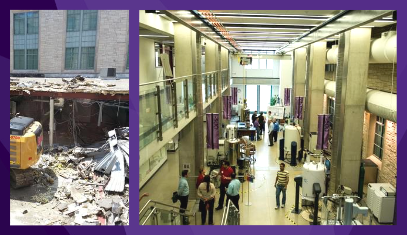Breaking Boundaries in Collaborative Research (Part 2): ASL's Metamorphosis into IMSERC

By Kelly Levander
For over 50 years, Northwestern Chemistry has emerged as a global leader in scientific research and education, thanks in large part to the establishment of the Analytical Services Lab (ASL) and its subsequent expansion into the Integrated Molecular Structure Education and Research Center (IMSERC). As a premier analytical laboratory, IMSERC plays a pivotal role in supporting cutting-edge research and training the next generation of scientific leaders.
The impetus for investing in the expansion and upgrade of research facilities at NU arose in 2005 when the Department recognized the growing demand for enhanced capabilities in ASL. Rick Silverman was a key player in enabling the expansion of ASL into IMSERC. His drug compound pregabalin (Lyrica) entered the market in 2005, generating royalties and intellectual property that financially supported the Department's facilities expansion and recruitment efforts. Additionally, Chad Mirkin and Mark Ratner raised over $100 million to establish NU as a frontrunner in nanotechnology, attracting leading experts like J. Fraser Stoddart and his team of 20 researchers.
Plans were set in motion in 2008 to demolish the current ASL, located on the ground floor in KG73, and significantly expand into Wings B and C. The new location not only provided additional program space for equipment needs but also served as a facility to showcase research and educate students.
The renaming of ASL to IMSERC was driven by the commitment to maintain the university's focus on education and training while supporting world-class research. IMSERC serves as a one-stop-shop open-access facility, offering a wide range of state-of-the-art analytical instrumentation. In 2008, the facility was officially renamed IMSERC after incorporating significant new capabilities.
In 2013, NU scientists completed the move into their new IMSERC facilities, marking an exciting time for advanced research endeavors for both faculty and students.
Currently, IMSERC boasts a team of eight dedicated full-time staff members, collectively possessing over 160 years of experience in their respective fields. Their expertise extends to all aspects of experimental design, data collection, interpretation, and analysis. They play a crucial role in preparing research proposals and publications, as well as training undergraduate and graduate students and post-doctoral researchers in the use of analytical instruments. The center conducts 500 training sessions and approximately 70,000 experiments annually.
IMSERC currently houses nine mass spectrometers, six amplified nuclear magnetic resonance (NMR) spectrometers, six X-Ray diffractometers, and several other instruments for physical and optical characterization. Most users at NU receive training from IMSERC staff and conduct their experiments independently. Additionally, IMSERC offers analytical services to both internal and external users on a fee-for-service basis.
IMSERC is now preparing for exciting upgrades to be implemented by Fall 2023, driven in part by the arrival of Songi Han. The Han lab is pioneering advancements in electron and nuclear spin magnetic resonance instrumentation, as well as dynamic nuclear polarization (DNP), amplified NMR, and electron paramagnetic resonance (EPR). Northwestern Chemistry exemplifies its steadfast dedication to students and faculty through investments in cutting-edge advancements, showcasing an unwavering commitment to outstanding research, state-of-the-art facilities, and comprehensive training.
Visit the IMSERC website for more information on how to access these top-of-the-line facilities.
